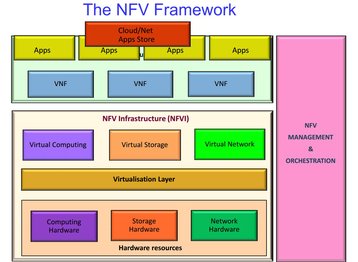Incumbent vendors will have trouble in the world of NFV, according to a senior BT expert. And network hardware could soon welcome a new device: the “rouver”.
Small, nimble vendors offering software defined networks (SDN) and network function virtualization (NFV) are sneaking up on the more established vendors and will cause major disruption in the market this year said Chris Bilton, BT’s director of research and technology, at an event in Nice this week.
“There are some really interesting solutions from less well known, smaller vendors out there that are probably stealing a march on bigger players,” he said. “The difference the last nine months has made is absolutely remarkable and I’m sure the next six to nine months will see another shake-out that will be of benefit to operators.”
In the last 12 months, plenty of NFV demos have shown virtualized services work. The task now is to prove that the solutions are robust enough to go into long-term service. The need for ‘carrier-grade reliability’ is essential, said Bilton.
How the startup landscape is shaping up
The landscape of startups is widening. Orange has been working with a range of NFV and SDN specialists on services. Its partners include Activiti (at the orchestration layer level), UBIqube Solutions SA c(on the VNF manager), Juniper Networks Inc. (whose Contrail technology is used for the SDN controller) and Versa Networks (on VNF).
Operators are attracted to NFV and SDN technology because it allows them, theoretically, to use a variety of network suppliers and not be ‘locked in’ to a single vendor’s solutions. In his talk Bilton stopped short of advocating a multivendor strategy outright but emphasized the importance of ‘modularity’ and ‘interoperability.’
“Telcos like to buy boilerplate capabilities and integrate a lot of that together themselves, acting as the systems integrators in many cases,” he said. “The IT industry typically buys integrated solutions and you’ll see a flexing of these two models in future. There’ll definitely be some supply side mash-up and open source will be a really important area.”
Rouver to you
The BT executive also cited a device he called the “rouver” as a new example of the convergence taking place between the IT and telecom sectors. Described as a cross between a router and a server, the rouver could help to reduce costs and support different network functions at customer premises, according to Bilton.
“These devices are being developed by a number of companies and will have a lot of benefits,” he said - although DatacenterDynamics hasn’t yet been able to Google out any actual examples using the term.
OpenStack emerged four years ago as an open source platform for building private and public cloud environments. In a relatively short time, it has gained a great deal of interest from hardware and software vendors, service providers, enterprises, and the investment community. The project has seen increased momentum recently as more developers and end users have united to build out OpenStack’s capabilities.
Mario Bonnet, head of network virtualization for the Italian operator, Italia SpA said at the Nice event that telcos were facing a number of challenges on the orchestration front, with orchestrators ‘popping up like mushrooms on a rainy day.’
Service orchestration is a problem DatacenterDynamics has focused on in the past, and one which has produced a few nimble players such as CENX. Bonnet said: “Is there a mature multivendor orchestrator environment? We find it difficult to have orchestration between products from different vendors … and there is a risk we end up with virtualized silos that are not effective anymore.”
Why orchestration technology will blossom
The fact is that there is a need for more orchestration functionality to be proven so that service providers can scale their networks through the automation of the implementation composition of network functions and services.
The placement of network functions carefully mapped to the best capabilities of the computing platforms enables network services orchestration through companies such as CENX, Glue Networks and Netronome (NSO) to achieve the best performance. Demos of Netronome’s NSO in practice in a multi-vendor environment exist.
NFV orchestration is also the specialty of MYCOM OSI. The company yesterday announced “an NFV solution that automatically directs NFV orchestration actions based on end-to-end service assurance factors, such as faults and degradations, across hybrid, traditional and virtual networks.”
Another NVF orchestration initiative was launched a month ago by InterCloud Systems Inc., which launched NFVGrid, an NFV orchestration platform. Ciena Corp has also just announced it is buying SDN/NFV orchestration technology through the acquisition of Cyan Inc. Cyan’s “SDN, NFV, and packet-optical solutions deliver orchestration, agility and scale to networks that up until now have been hardware driven,” it said in a statement.
“Although the telecom industry is still in the early days of NFV and SDN, we see orchestration technology starting to bloom,” Infonetics said in a research report. Each NFV use case or SDN network domain requires an orchestration system, and when the operator wants to coordinate two or more domains, a multi-domain or cross-domain orchestration system is required. And therein lies the fertile ground for the growth of layers of orchestration systems that will inevitably spring forth to help automate network operation from services to the physical network.”
The open source community is also a key enabler of the maturing phase, including projects such as the Nova and Neutron software developments that are building orchestration functionality into OpenStack. The Open Platform for NFV (OPNFV) project is focused on hardening the NFV infrastructure and improving infrastructure management, which should improve the performance predictability of NFV services.


